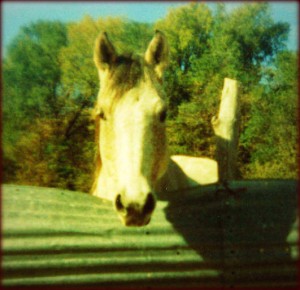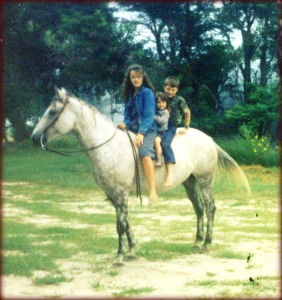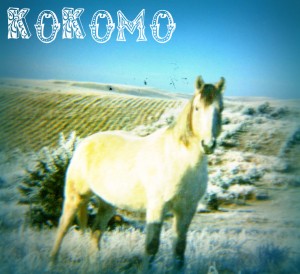 In my years of growing up with horses, if there was one horse who was there through thick and thin, solid and dependable, and forever golden in my memory, it was Kokomo. He was a brother to Apache, my sister Kandra’s first horse, so he was grade with some Pinto, Arabian, and maybe Quarter Horse in him. It didn’t matter, he was one of those great ranch horses who require no pedigree to achieve greatness.
In my years of growing up with horses, if there was one horse who was there through thick and thin, solid and dependable, and forever golden in my memory, it was Kokomo. He was a brother to Apache, my sister Kandra’s first horse, so he was grade with some Pinto, Arabian, and maybe Quarter Horse in him. It didn’t matter, he was one of those great ranch horses who require no pedigree to achieve greatness.
Kokomo had a neat color to him. He started out a dark brown, and by age two he was a grulla, which is kind of a mouse color with dark legs, mane, and a dorsal stripe. Before long, his color had faded to white, with variations depending on the season. Summer would bring out some chestnut flecks in his coat, which I guess is called “flea-bitten gray”, and by winter he was a hairy fluff of cream colored fur.
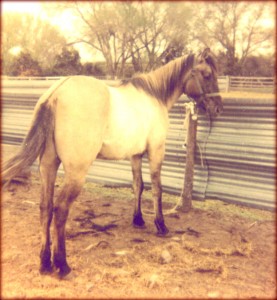
Kokomo was born in 1982, and must have started training very early, because I remember riding him when he was three years old, and I was only seven. We grew up together. I remember we had “Old Fashioned Sunday” at our church the day I was baptized. My sisters and I rode our horses the five miles or so it was into town, and I got to ride Kokomo. A few other church members rode horses in for church, and everyone was dressed in old fashioned western attire. It was a fun day that I’ll never forget.
My dad used Kokomo as his main ranch horse for many years. Kokomo wasn’t a big horse, maybe 14.2 hands, but he was great for roping calves, sorting cattle, and riding pasture. As Kokomo got older and we girls had some younger horses progressing well enough in their training, my dad started riding some of the younger ones that were faster and more agile for cattle work. I always thought it kind of hurt Kokomo’s feelings to be passed over for the youngsters. He was always the boss horse of the herd, and nobody talked smack to him. Once in a great while, Dad would saddle Koker up to give his other horses a rest, and you should have seen that old horse prance! He would arch his neck and step out in pride, happy to be “top horse” again in Dad’s book, and he always worked much harder for Dad than he did for any other rider.
Kokomo was a kid horse for the majority of his life, though. He could be extremely lazy which made him good for beginners and visitors. Often if he didn’t want to go somewhere, he would just plain stop. If the rider squeezed or kicked him, he would give a little warning hop with his front feet, saying “Don’t push me, I will rear with you!” He never hurt anyone with this maneuver, it was generally just his way of communicating to a lesser rider that he was in charge. I never saw him try that stunt with my dad, he was too smart.
This is a photo of me riding Kokomo with my littlest sister and youngest brother. We often rode bareback if it was just a “fun” ride, and the horses never seemed to mind that we all climbed on and rode around crazily. Kokomo was perfect for rides like this, he had high energy when we could fool him into thinking it wasn’t “work”, and he was safe enough we never had to worry about him bolting, shying, or running for home.
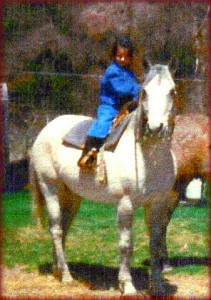 My youngest sister started out riding Kokomo, and he taught her everything about riding and working cattle. He was the kind of horse that would work on “auto pilot” in a herd of cattle, driving and pushing, and turning automatically after a calf that was lagging behind. I always think the most valuable horse in the world is the one who will work patiently and slowly with a little rider, yet can rise to the occasion when a cowboy steps on and needs a fast horse to rope on. Kokomo was that type of horse.
My youngest sister started out riding Kokomo, and he taught her everything about riding and working cattle. He was the kind of horse that would work on “auto pilot” in a herd of cattle, driving and pushing, and turning automatically after a calf that was lagging behind. I always think the most valuable horse in the world is the one who will work patiently and slowly with a little rider, yet can rise to the occasion when a cowboy steps on and needs a fast horse to rope on. Kokomo was that type of horse.
He lived to the ripe old age of twenty-six years, and we were blessed to have him. He taught each of us something, and to some of us he taught everything. I looked up the meaning of his name, which is an Indian word meaning “Black Walnut”. It was a name that fit him well, because it signifies his dependability, usefulness, value, and beauty. Kokomo was a horse I will never forget.
